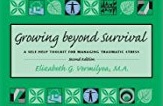Growing beyond survival – a self-help toolkit for managing traumatic stress – by Elisabeth Vermilyea
 Written for: people with PTSD
Written for: people with PTSD
Special focus: self-help, practical exercises
What it is not:
- a book specifically about coping with extreme dissociation
- about DID
Language: Everything is explained step by step, psychological terms are explained with easy language. It is exceptionally well written. It has not been translated (which is a pity)
Book: it is a bigger format that makes it easy to copy the worksheets in it. It is moderately expensive, just at the limit of what we would be willing and able to pay. The second (revised) edition came out in 2013
Overview
Part 1
Offers a crash course on
- child development and the impact of trauma
- the flight/fight response
- diagnostic criteria for PTSD,
- dissociation and
- DID
- co-morbid disorders
and the possibility to find out where you are at in all of this.
All the essentials are covered in just a few pages. The density of information in this book is remarkable.
Part 2
introduces the basic tools of the tool kit
- self-regulation
- grounding/mindfulness
- reality checks (flashbacks)
- imagery (safe place)
- gauge
- regulator
- containment
- journal writing
- safety (+ safety plan)
- relaxation
- sleep
Every chapter starts with a short explanation why the tool is important for PTSD, then explains how to use the tool and ends with at least one worksheet (sometimes up to 4) to deepen the understanding and help with the practical use of the tool.
The chapters are short (1-2 pages), simple and practical. It introduces the essentials.
Part 3
touches on
- self-awareness and the problem of dissociation
- boundaries
- dealing with shame
- dealing with anger
The worksheets build on skills of self-reflection that were practiced earlier in the book and need very personal answers and time to think. The focus widens to include relationships to other people.
Part 4
needs the combination of the tools from the basic tool box to help you cope, while you learn how to
- regulate and challenge your thoughts
- regulate your feelings
- regulate your impulses
- regulate sensory experiences (triggers& flashbacks)
These chapters are serious work. They lead you to analyse what is going on inside of you, so that you can understand it and change it. This can be stressful in itself, which is why you need to master the tools from the basic tool box before turning to this advanced section.
The book ends with a short chapter about the usefulness of support groups.
After reading
we thought about giving up the blog because it is all said in a much better way in this book. Then recovered from the shock and took the style of how this is written as a role model for our blog.
We believe that this book is an essential in a PTSD bookshelf. If you do what it says you have all the most basic tools to overcome your PTSD. It doesn’t have magic solutions, but the tools that are proven to work.
Everything described is useful to master for DID as well.
We find the clear structure and minimalist style very helpful for our limited attention span and focus, as well as our need for simple structures.
While it says that this is a self-help book it can easily be used by therapists to ensure a solid base of stabilization for future trauma work.
This book is all that it is promising to be while staying humble and unpretentious.


Leave a Reply